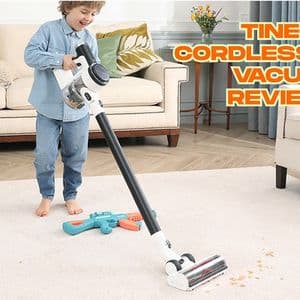Why Suction Power Matters in Cordless Vacuums
Let’s face it—no one wants a vacuum that barely picks up crumbs.
In cordless vacuums, suction power directly impacts how well the device lifts dirt, debris, pet hair, and fine dust from different surfaces. Unlike corded models, cordless vacuums rely on battery-powered motors, so understanding the right balance between performance and runtime is key.
What Does Suction Power Really Mean?
Before diving into numbers, let’s define what we’re talking about.
Suction power is usually measured in:
-
Air Watts (AW) – This is the most accurate unit for vacuum performance. It considers both airflow and water lift.
-
Pascals (Pa) – Common in robot or handheld vacuum specs, indicating pressure difference.
-
Cubic Feet per Minute (CFM) – Represents airflow, but less common in cordless specs.
Of these, Air Watts is the most relevant for cordless vacuum cleaners.
Recommended Suction Power for Different Cleaning Tasks
Here’s the million-dollar question: how much is enough?
Light Cleaning on Hard Floors
If you're mainly vacuuming hardwood, tile, or linoleum, you don’t need excessive power.
-
Good suction power range: 50–70 AW
This level works well for loose dust, hair, and small particles.
Medium Cleaning on Low-Pile Carpet
For area rugs or low-pile carpeting, more strength is required.
-
Recommended: 70–100 AW
This ensures effective dirt extraction while maintaining decent battery life.
Heavy-Duty on Thick Carpet or Pet Hair
This is where power really counts.
-
Ideal range: 100–150 AW
Premium cordless models in this range handle deep carpet fibers and stubborn pet hair more effectively.
Factors That Affect Suction Efficiency
Here’s where it gets interesting.
Suction power alone doesn’t determine performance. Let’s unpack a few other key elements:
Battery Voltage and Type
Higher voltage (e.g., 25V or above) often supports stronger motors, while lithium-ion batteries sustain power longer without fading.
Filtration System
HEPA filters improve air quality but may restrict airflow if clogged. A clean filter maintains suction performance.
Nozzle and Brush Head Design
An efficient motorized brush head can amplify suction effectiveness—especially on carpet—even if the AW is moderate.
Read more: Cordless Lightweight Vacuums
The Balance Between Suction Power and Battery Life
There’s a catch: more power often means less runtime.
High-powered cordless vacuums may only last 10–20 minutes on their maximum setting. That’s why many devices offer multiple power modes:
-
Eco Mode – Longer runtime, lower suction.
-
Standard Mode – Balanced performance.
-
Max or Turbo Mode – Short bursts of high suction for tough jobs.
For most users, standard mode with 70–100 AW hits the sweet spot between performance and battery longevity.
Suction Power: New Models vs. Older Units
Technology is moving fast.
Modern cordless vacuums often outperform older plug-in models. Improvements in motor efficiency, digital controls, and battery systems have raised the performance ceiling significantly.
Some top-performing cordless vacuums rival corded ones in suction—but they come at a higher price and are often heavier.
How to Compare Models Without Standardized Specs
Here’s the problem: not every manufacturer lists AW or Pa ratings clearly.
So what can you do?
-
Look for third-party test results.
-
Read performance-based reviews.
-
Consider the surface types you’ll be cleaning most.
For example, if you're researching a cordless stick broom, it’s wise to check how it handles both hard floors and area rugs—not just what the box says.
When “More” Isn’t Always “Better”
Let’s slow down.
Too much suction can be a problem—especially on delicate rugs or light mats. Strong motors may pull or drag lighter materials, making cleaning frustrating.
That’s why adjustable suction settings are valuable. They let you tailor power to each cleaning task without switching tools or vacuums.
What Role Does Dustbin Design Play?
This might surprise you: a poorly designed dustbin can reduce effective suction.
When bins are too full or filters are clogged, airflow drops. That means even a 120 AW vacuum may feel like a 40 AW model. Regular emptying and maintenance keep your suction strong.
The Truth About Dyson and Other Premium Brands
You’ve likely seen vacuum cleaner reviews Dyson enthusiasts post online. Many praise their models for high suction performance, especially in "Boost" mode—sometimes exceeding 150 AW.
But even mid-tier models can deliver good performance if they’re well designed. Brand is one factor, but not the only one that matters.
Choosing the Right Suction Power for Your Needs
Here’s a quick breakdown to help guide your expectations:
| Cleaning Need | Recommended Suction (AW) | Notes |
|---|---|---|
| Bare floors, light messes | 50–70 AW | Great for daily quick cleans |
| Low to medium carpet | 70–100 AW | Most common sweet spot |
| Pet hair, thick carpet | 100–150 AW | Requires stronger brush and filter system |
| Deep-cleaning, all surfaces | 120+ AW | Short runtime—ideal for specific areas |
Final Thoughts
So, what is a good suction power for cordless vacuum cleaner? The answer depends on your floor types, lifestyle, and expectations. For most households, a vacuum delivering between 70 to 100 Air Watts will offer solid all-around performance. Power alone doesn't tell the full story—consider features, battery life, and ease of maintenance when choosing.
If you found this guide helpful, feel free to share it with others who might be shopping or upgrading their cleaning tools.










